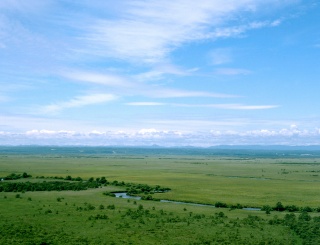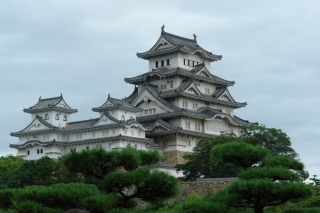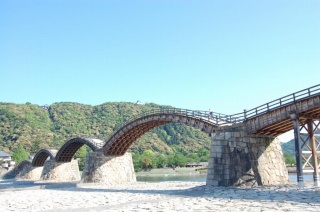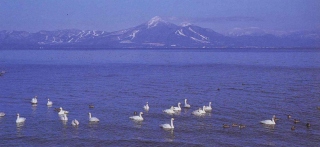Sister Cities in Japan
-
Kushiro City / Himeji City / Iwakuni City / Koriyama City
- Kushiro Shitsugen National Park
The Kushiro Shitsugen National Park is the largest wetland in Japan. With an area of 26.861ha it is 5600 times as large as the Tokyo Dome. The wetlands are home to about 2000 species of flora and fauna, some of them, such as the Red-crowned Crane are designated as special natural monuments. - Red-crowned Crane Natural Park
The park covers an area of about 10ha with currently about 20 cranes inhabiting the park. - Tottori Historical Museum
The Tottori Historical Museum was built at the site of the old settlement of the samurai from Tottori and resembles Tottori Castle. The museum displays personal effects and family treasures of the Tottori domain lord Ikeda family. - Kushiro Ice Festival(early February)
- Kushiro Tulip Fair (the last Sunday of May)
- Kushiro Port Festival (over three days from the first Friday in August)
- Kushiro Tairyo Donpaku Festival (early September)
- Kushiro Shitsugen Marathon (late July)
- Himeji Castle
Himeji Castle is one of Japan's national treasures and also known as "White Heron Castle" because it resembles a white heron spreading its wings and flying to the sky. It was constructed in 1601 by Terumasa Ikeda, a warlord during the Edo period and is one of the largest wooden buildings in the world. Together with the Horyuji Temple it was registered in 1993 as Japan's first world cultural heritages. - Mt. Shosha
Although Mt. Shosan lies in close proximity to Himeji city and is only 371m high, it emanates the tranquil atmosphere of a much taller mountain. Upon getting off the ropeway which leads up to the mountain, a scenery of deep, dark mountain valleys silently unfolds. At the top of the mountain is Engyoji Temple, which was founded 1000 years ago. - Yukata Festival (June 22 and 23)
- Nada Festival (October 14 and 15)
- Oshio Lion Dance Festival (October 14 and 15)
- Kintai Bridge
The wooden Kintai Bridge with its five arches is the symbol of Iwakuni and one of the three most beautiful bridges in Japan. It was constructed in 1673 and designated as a place of extraordinary scenic beauty in 1922.
- Iwakuni Castle
The original Iwakuni Castle was constructed as a mountain castle in 1608 and later rebuilt in 1962. A ropeway leads up to the castle, and the observation deck on the 4th floor offers a splendid view.
- Kikko Park
This large park contains the Kinunkaku Pavilion with its exhibition of wooden votive tablets, the Nagayamon Gate and the Chokokan Museum of local history. The park’s many flowers and trees such as camellia, cherry and Japanese plum (Ume) trees and azaleas are an attractive and beautiful sight during all four seasons.
- Kintai Bridge Festival (April 29)
- Cormorant Fishing in Iwakuni (June - August)
- Nishiki River Water Festival (the first Saturday of August)
- Iwakuni Festival (the third Saturday and Sunday of October)
- Inawashiro Lake
The size of the Inawashiro Lake, which is the fourth largest in Japan, and its extraordinarily clear water make it one of the most famous sightseeing spots in Tohoku region being especially popular with marine sports and camping tourists. Incidentally, it is also a known for being a wintering spot of migrating swans. - Kaiseikan Hall
The Kaiseikan Hall is a western-style building originally constructed to be used as a local community hall in 1874. Now it displays the traces of the people involved in the Asaka Cultivation. - Big-i
The "Big-i" is a 24floor high-rise building and a landmark of Koriyama City. The top four floors are occupied by the Koriyama City Fureai Science Center “Space Park” whose planetarium is recorded in the Guinness book as being the tallest in the world. - Cherry blossom festival (mid April)
- Beer festival (late July - early August)
- Koriyama Uneme Festival (the first Friday of August - Sunday)
- Koriyama Agriculture, Sightseeing, Local Product Exhibition (mid Oct)
- Bandai Atami Hot Spring Tsururinko Festival (early December)
Kushiro City, Hokkaido
 |
Sister city since October 4th, 1963 Kushiro City (official web site) (Japanese and English) |
Relationship with Tottori City
From 1884 to the following year, 513 samurai from 105 old Tottori feudal clan families sailed from Karo Port for Kushiro to develop the land and settle there. After years of hardship, they established Tottori Village. Although the village was incorporated into Kushiro City in 1949, the former village now makes up three quarters of the total area of Kushiro City and about the half of Kushiro City’s population live there.
Sightseeing
Local Specialties and Souvenirs
Ikura-don(salmon eggs on rice), Sanpei-jiru(local soup), Sardine Sushi, Kani-zosui(crab and rice soup),
Hokkai-nabe(local hot pot)
Annual Events
Himeji City, Hyogo Pref.
 |
Sister city since March 8th, 1972 Himeji City (official web site) (Japanese, English, and Chinese) |
Relationship with Tottori City
The relationship between the two cities originates from two significant events: in 1600, when Nagayoshi Ikeda, a younger brother of the Himeji Castle lord Terumasa Ikeda, was given the Tottori Castle and in 1617, when Mitsumasa Ikeda became lord of the Tottori domain, which yielded 57.6 million liters of rice. The two cities are now connected by the National Road Route 29 and the Chizu Express Railway, providing easy access between the two cities.
Sightseeing
Local Specialties and Souvenirs
Bamboo shoot dishes, hand-made somen (Japanese thin white noodles), conger eels, Tamatsubaki (sweet buns), Dutch sweets, Himeji leather crafts, Himeji papier-mache dolls, Myochin-Hibashi (pairs of tongs)
Annual Eventsl
Iwakuni City, Yamaguchi Pref.
 |
Sister city since October 13th, 1995 Iwakuni City (official web site) (Japanese and English) |
Relationship with Tottori City
In 1581, Toyotomi Hideyoshi (then still known as Hashiba Hideyoshi) attacked and sieged Tottori Castle. To save his soldiers and citizens from starvation the 35 year old castle lord Kikkawa Tsuneie offered to take his life. Thus, the people were spared and Tsuneie came to be called the "lifesaver of Tottori". His descendents later served for generations as retainers of the Iwakuni clan and since then, strong ties of friendship exist between the two cities.
Past and Present
The origins of Iwakuni date back to 1600, when, after the Battle of Sekigahara, Kikkawa Hiroie constructed Iwakuni Castle. For about 300 years, until the Meiji Restoration, Iwakuni flourished as a peaceful castle town. Today, it plays an important role in the industrial landscape of the Seto Inland Sea industrial area.
Sightseeing
Local Specialties and Souvenirs
Iwakuni Sushi, Lotus roots dishes, Iwakuni chestnuts, sweetfish dishes, stone dolls, Kintai senbei (rice crackers)
Annual Events
Koriyama City, Fukushima Pref.
 |
Sister city since November 25th, 2005 Koriyama City (official web site) (Japanese, English, and Chinese) |
Relationship with Tottori City
From 1880 to 1887, more than 270 samurai from 67 old Tottori feudal clan families immigrated to Koyahara (today Koriyama City Kikuta-machi) to engage in the “Asaka Cultivation”, a national project to develop the then barren land of the Asaka Wilderness. After overcoming many hardships,they successfully completed the project. Since then, various activities such as the joint research into the immigration and exchange activities between the descendants of the immigrants and Tottori City citizens continue.
Sightseeing
Local Specialties and Souvenirs
"Asaka-mai" rice, Carps, Papier-mache dolls, Konan Highlands buckwheat noodles, Nunobiki Highlands Radish, Pears, Sake
Annual Events
